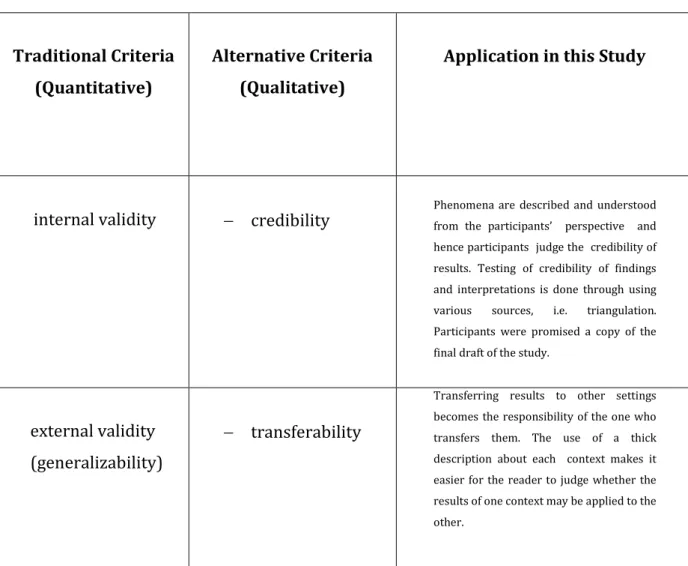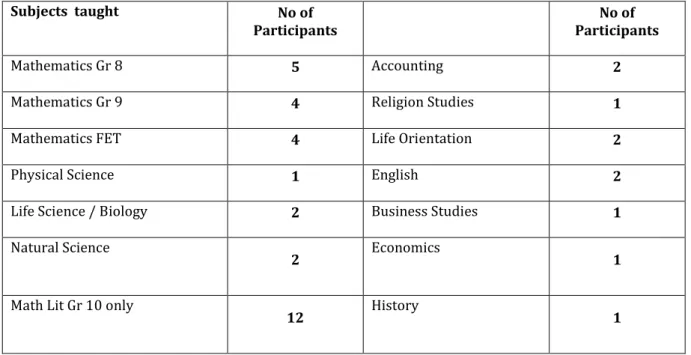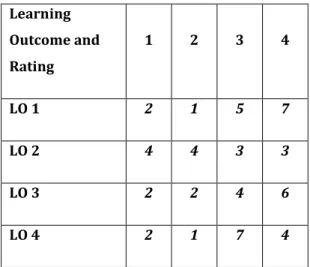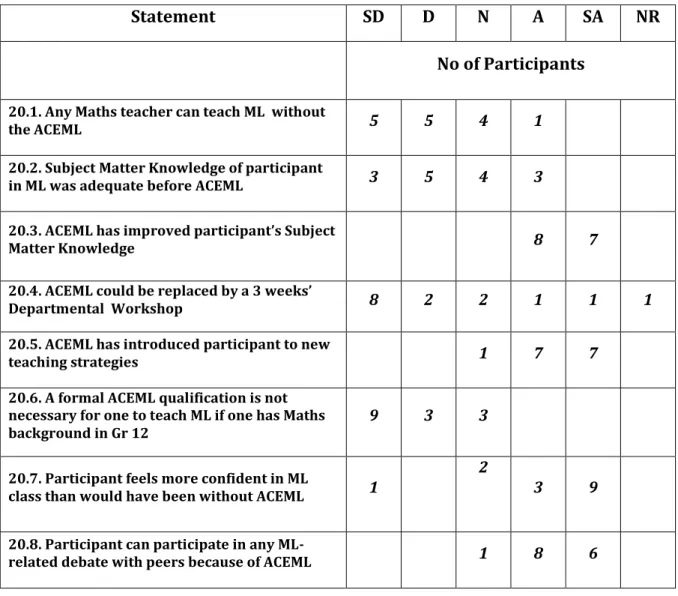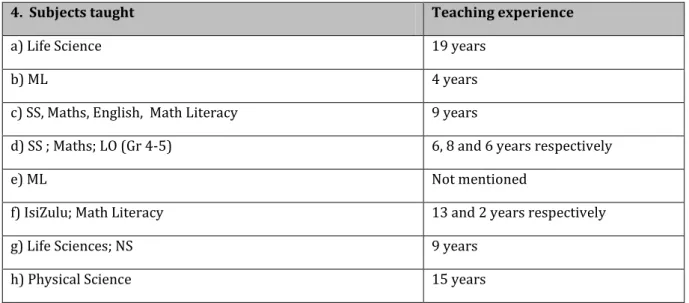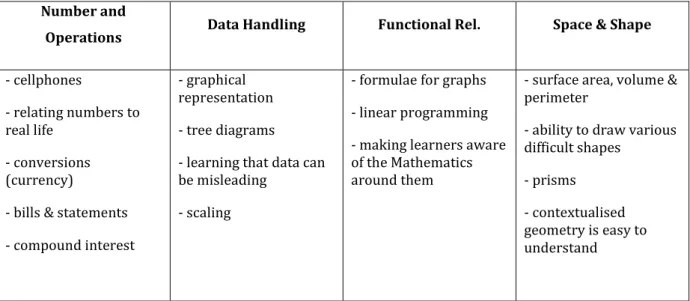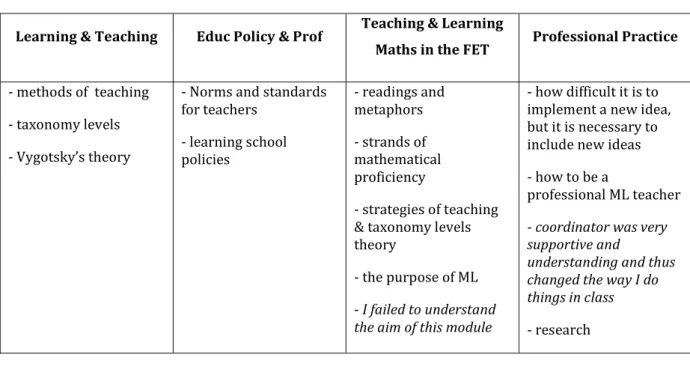CHAPTER 1: Overview and Focus of the Study 1
Mathematical Literacy as a School Subject
Most adults in South Africa complete their mathematics education at grade 9, while the workplace requires “meaningful use of basic numerical and spatial skills” (DoE, 2008, p. 7). According to Chisholm et al., (2000), the cascade model “failed to prepare either officials or school-based educators for the complexities of C2005 implementation.
Background to the Context of the Study
The Outline of the Curriculum in the ACEML
The remaining two modules were devoted to the philosophy behind ML and practical applications in the field. These modules were therefore considered necessary for the teachers' professional development.
Rationale and purpose of the Study
These two modules were Learning and Teaching, a module that “explores the connections between the social and the individual [and] considers the cognitive development of students to help us understand the levels of the students we teach, and also considers learning and behavior” (Akhurst, Sader&Ntoi, 2005), as well as Education Policy and Professionalism. The purpose of this study is therefore to investigate the professional development of teachers as a result of teachers' participation in the program.
Personal Motivation for the Study
This raises legitimate questions about the role of the ACEML program in the lives of these teachers. Teachers' beliefs about the ML subject that were based on their knowledge of the purpose of the subject needed to be explored.
Objectives of the Study
11 1) In what ways has participation in the Advanced Certificate in Education in Mathematical Literacy increased the teachers' professional development?. It is hoped that the results of the study will help explain the professional development of teachers as a result of their participation in the ACEML program.
Significance of the Study
11 1) What are the ways in which participation in the Advanced Certificate in Mathematical Literacy Education enhanced teachers' professional development? . 2) How participation in the ACEML program increased teachers' professional development. What were the implications of the program as a whole on the professional development of the teachers involved.
Organisation of the Study
The majority of participants (11) said that mentors were considerate and empathetic and treated them as colleagues and adults (12 participants). So I already knew some aspects, and some I learned in the ACEML program.
CHAPTER 2: Literature Review and Theoretical Framework 13
General Issues of Professional Development
One of the expectations in the ACEML program was that teachers would develop substantive pedagogy specific to the subject of ML. As a result, building that trust remains one of the expected outcomes of participating in the ACEML program.
The Mathematical Literacy Purpose and Philosophy
Mathematical literacy provides students with an awareness and understanding of the role that mathematics plays in the modern world. The role of the teacher in an ML classroom becomes central in the sense that the only form of assessment used in ML is.
Mathematical Literacy Teachers and the Subject ML
24 with the opportunity to demonstrate both competence with Mathematical content and make sense of the world" (Debba, 2011, p. 31). She also pointed out that teachers needed to add "the knowledge of the GET math curriculum to their own knowledge to be informed about students' expected prior math knowledge" (Hechter, 2011, p.149).
Theoretical Framework
- Content Knowledge
- Pedagogic Content Knowledge
- Identity and Beliefs as ML Teachers
This knowledge helps lay a good foundation for the student's future learning. Therefore, the teacher must have a good understanding of the contexts that are set in the curriculum.
Introduction
Methodology Chosen
The study is based on the naturalistic interpretive paradigm, which believes that the social world can only be understood from the point of view of those individuals who are part of the ongoing events under investigation (Cohen et al., 2007). Although the data can sometimes be quantified, the analysis is interpretive in order to determine how the professional development of the participants was enhanced.
Data Sources and Data Collection
- Why was data collected?
- Data Sources
- The Participants of the Study
- Participants in the Questionnaires
- Participants in the Interview
- Participants in the Second Questionnaire [Questionnaire B]
The second part was designed to identify participants' impressions of the ACEML program. Unlike in the structured interview, where "the context and procedures are organized in advance, determining the order and wording of the questions using a scheme" (Cohen et al., 2007, p.355), a semi-structured interview is . an open situation which has greater flexibility and freedom.
Data Analysis
The first part of Section B (questions 5 to 9) consisted of Likert scale questions where teachers had to give their impressions of the ACEML program. The tables were useful in that they allow the reader to “see at a glance where there are differences and similarities between individuals” (Cohen et al., 2007, p. 466).
Validity and Trustworthiness
The data collection procedures and analyzes are not certified by the researcher, but by the data itself. Cresswell & Miller (2000) further argue that it is the researcher who determines whether the “data are saturated to establish good themes or categories, and how the analysis of the data evolves into a compelling story.”
Ethical Considerations
Challenges of the Study
- Identifying Suitable Participants for the Questionnaire
- Identifying Suitable Participants for the Interviews
- Avoiding Researcher Bias
SP believed that most of the teachers who came to study in the ACEML had one goal. The study could not examine the content knowledge of the teachers before and after their participation in the program. 114 teachers identify the most suitable, in terms of the shortage in schools, to enroll and participate in the ACEML program.
117 The participants reported that none of the above would have been achieved without full participation in the ACEML programme. Is there any aspect of the subject ML that you feel you learned somewhere other than in the ACEML program.
CHAPTER 4: Results 51
The Report on the First Group of Questionnaires [Questionnaire A]
The questionnaires revealed that the majority (twelve out of fifteen) of the participants had taught 10th grade ML in the past few years. Twelve of the participants agreed that they were currently learning ML while three were not. Ten of the participants agreed that the tutors knew the content well, 3 strongly agreed and two were neutral.
Seven of the participants said that the supervisors were always well prepared, while four said that they strongly agreed. When asked about dropping out themselves, 13 of the participants said they never considered dropping out.

The Report on the Second Group of Questionnaires [Questionnaire B]
I didn't think I would be able to teach him.” In an interview, she revealed that she has no intention of teaching ML after completing the program. Miss UN does not seem to attribute her change in teaching strategies to the generic modules of the ACEML program. 93 namely to learn more about the content that should be taught in ML.
It is because of ACEML that some teachers (for example participants A3, A10, A14) are currently improving their studies in the areas of mathematics education, mathematical literacy and other areas. How would you describe your teacher professional development expected to be achieved by studying the ACEML program?
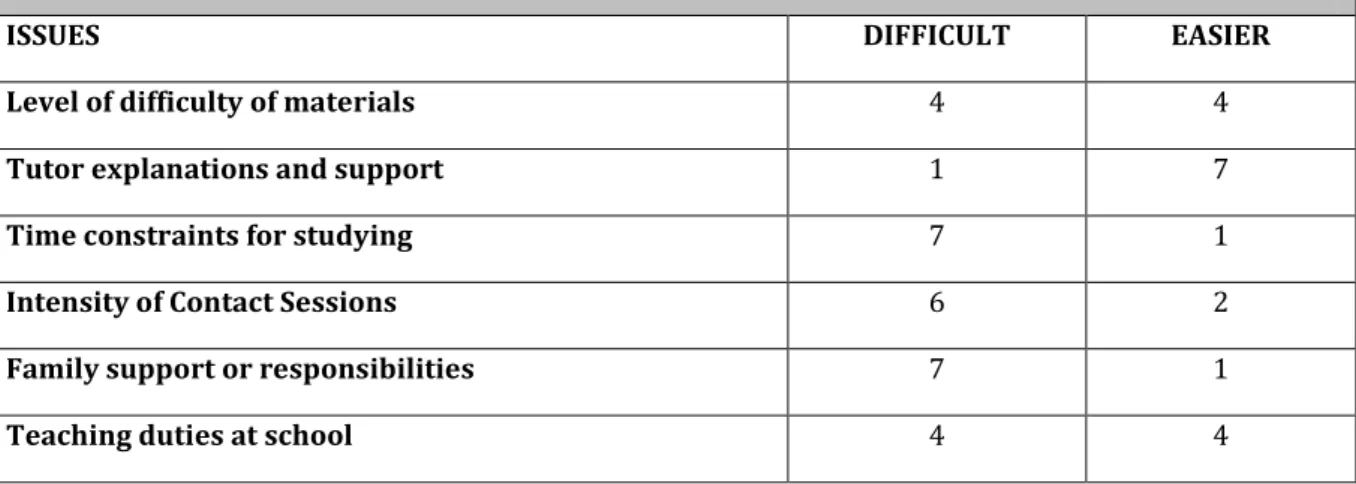
The Report on the Interviews with Participants
- Teacher A: Miss ZN - Biography
- Teacher B: Mrs PSK - Biography
- Teacher C: Mr. PN - Biography
- Teacher D: Mrs. SP - Biography
CHAPTER 5: Discussion and Conclusion 89
On the Knowledge of Content Specific Pedagogy
For example, Miss ZN felt that such modules should not have been included in the syllabus. There are consistent reports that teachers have changed and improved their teaching strategies as a result of their involvement in the ACEML program. Fourteen teachers in Questionnaire A, Question 20.12 generally felt that they would not have been able to teach ML successfully if they had not enrolled in the ACEML program.
This was a practice he had ignored while teaching mathematics and before entering the ACEML program. All teachers participating in the ACEML taught in other specializations before enrolling in the program.
Limitations of the Study
- Sampling
- Obervations
- Self-Reported Data
- Inability to Locate Drop-outs and those who Returned to Previous
- Avoiding the Hawthorne Effect
Failure to locate teachers who dropped out of the program made it difficult from their own perspective to find out why they had done so. Their reasons could have provided some insight that may have been obscured in this study. The author goes on to say that this phenomenon is one of the “hardest built-in biases to eliminate” (Shuttleworth, 2009, p. 1).
113 of the teachers' responses could be manipulated by the fact that they were closer to the researcher, in terms of work, so that they were easily tempted to give answers that they thought were expected by the researcher. Although these studies were also useful, it would be ideal to find more studies that specifically addressed teacher professional development within the subject area of mathematical literacy.
Recommendations
This study found that some program participants were teachers who had very limited knowledge of the basic ML subject content requirement, namely GET mathematical content knowledge. In programmatic terms, these institutions should ensure that they provide their training according to the basic needs of teachers, which, according to this study, is content knowledge in the ML subject. This study found that some teachers encountered difficulties in the field, even after completing ACEML, when faced with aspects of the curriculum they were unfamiliar with.
This could be one of the main factors contributing to the low Grade 12 pass rates experienced across South Africa in recent years. This suggests that the institution where these participants studied might consider evaluating whether the current structure of the ACEML could be revised in light of the many comments from teachers.
Final Conclusions
Would you also encourage any other teacher who wants to teach mathematical literacy to start studying the ACE Mathematical Literacy? Interviewer: So in short you're saying that every Mathematical Literacy teacher should have the ACEML. Would you have agreed to teach Mathematical Literacy if you had not studied the ACE?
Would you still agree to teach mathematical literacy if you hadn't studied ACEML. Interviewer: Now to you, would you agree to teach math literacy if you hadn't studied ACE. Interviewer: Is there any part, any aspect of the mathematical literacy course that you feel you already knew before you went to ACEML?
Now, the introduction of Mathematical Literacy at the university level, i.e. ACE for educators, was one of the wisest moves made by the University.
Certificate of Editing
